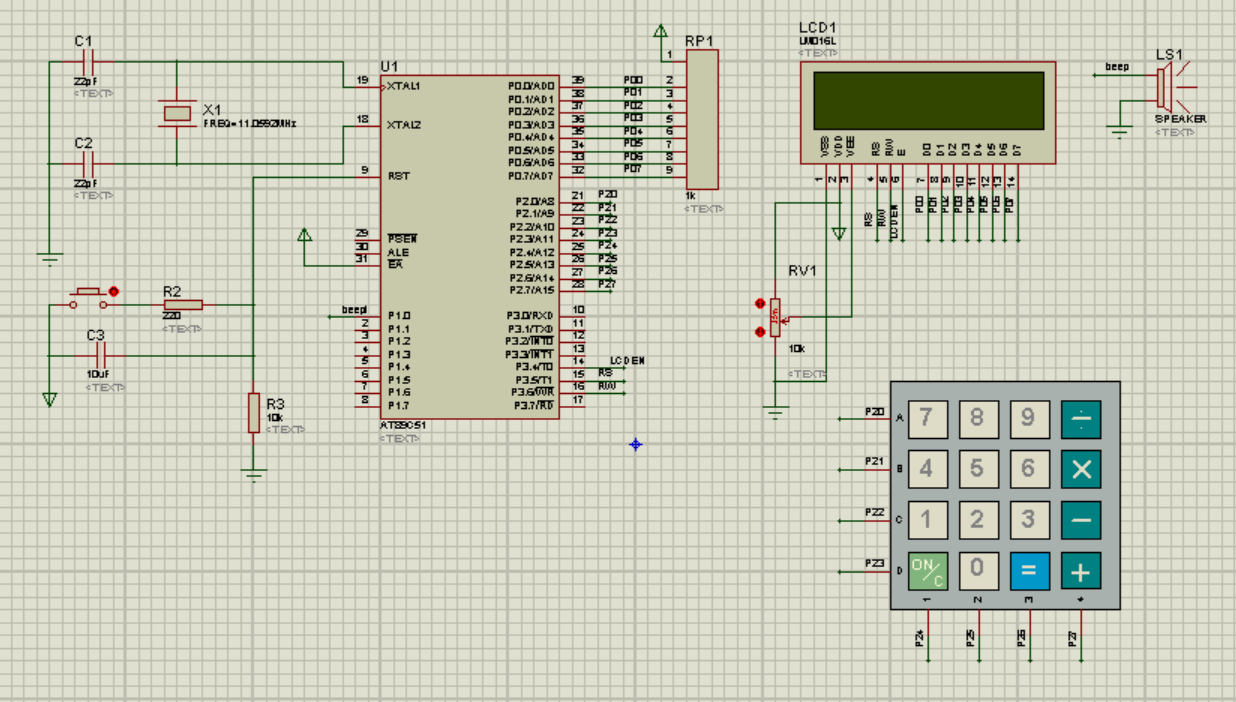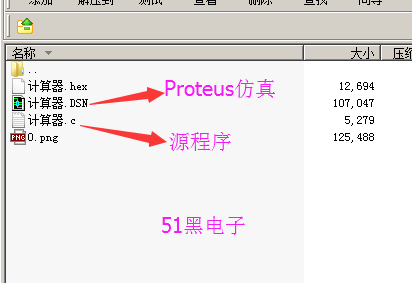我们在这里使用4*4的矩阵按键KEYPAD-SMALLCALC与1602液晶屏LMO16L在单片机上实现简单的计算器仿真实验。
首先我们定义一个字符数组存储按键对应的键值,使用程序查询的方法扫描矩阵按键;当结束输入时,我们就对字符串进行处理了并将结果显示在液晶屏上。
在程序中,适当的使用一些库函数可以大大提高我们的编程效率,在这里,我们主要对字符串进行操作,使用了stdlib.h、ctype.h库中的一些函数,如下:
atoi:将字符串转换成整数
atof:将字符串转换成浮点数
isalnum:测试是否为字母数字


单片机源程序如下:
- #include<reg51.h>
- #include<intrins.h>
- #include<ctype.h>
- #include<stdlib.h>
- #include<stdio.h>
- #include<math.h>
- #include<string.h>
- #define uchar unsigned char
- #define uint unsigned int
- sbit LCDEN=P3^4;
- sbit RS=P3^5;
- sbit RW=P3^6;
- sbit BF=P0^7;
- sbit BEEP=P1^0;
- uchar str[17];
-
- uchar code keyval[]="789/456*123-c0=+"; //按键对应的符号
- void delay(unsigned int xms)
- {
- int i,j;
- for(i=xms;i>0;i--)
- for(j=110;j>0;j--);
- }
- uchar keypad4_4()//按键扫描函数:要去抖,若有按键按下,返回对应的按键值(0-15),没有按键按下返回16
- {
- uchar i,row,temp;
- uchar key=16;//按键号,初值设置为16,目的是:没有按键按下时返回16;
- //若不设初值(默认值为0),没有按键按下时,将返回0,会误认为0被按下
- row=0xef; //从第一列开始
- for(i=0;i<4;i++)
- {
- P2=0xff;
- P2=row; //第i列信号,对应列为低,其他全为高
- row=_crol_(row,1); //生成下一列信号
- temp=P2; //读入扫描信号
- temp=temp&0x0f; //屏蔽高4位列信号,只保留低4位行信号
- if(temp!=0x0f)//有按键被按下,因为第i列某行有按键按下,则低4位中有一位为低
- {
- delay(20); //延时去抖
- temp=P2;
- temp=temp&0x0f;
- if(temp!=0x0f) //再次确认有按键被按下
- {
- switch(temp) //根据低4位行信号,判断哪个按键被按下
- {
- case 0x0e:key=0+i;break; //第i列第1行按键被按下
- case 0x0d:key=4+i;break; //第i列第2行按键被按下
- case 0x0b:key=8+i;break; //第i列第3行按键被按下
- case 0x07:key=12+i; //第i列第4行按键被按下
- }
-
- do
- {
- temp=P2; //再次扫描按键
- temp=temp&0x0f;
- }while(temp!=0x0f); //等待按键释放
- }
- }
- }
- return(key);//扫面结束,返回按键值
- }
- uchar RdACAdr()//读当前光标地址
- {
- uchar result;
- P2 = 0xff; //读地址前先置高电平,防止误判
- RS = 0;
- delay(5);
- RW = 1;
- LCDEN = 1;
- delay(5);
- result=P2&0x7f; //去掉最高位忙闲标记,只保留低7位地址值
- LCDEN = 0;
- return result;
- }
- uchar DectectBusyBit(void)//状态判断函数(忙/闲?)
- {
- bit result;
- P0 = 0xff; //读状态前先置高电平,防止误判
- RS = 0;
- delay(5);
- RW = 1;
- LCDEN = 1;
- delay(5);
- result=BF; //若LCM忙,则反复测试,在此处原地踏步;当LCM闲时,才往下继续
- LCDEN = 0;
- return result;
- }
- void WrComLCD(unsigned char ComVal)//写命令函数
- {
- while(DectectBusyBit()==1); //先检测LCM是否空闲
- RS = 0;
- delay(1);
- RW = 0;
- LCDEN = 1;
- P0 = ComVal;
- delay(1);
- LCDEN = 0;
- }
- void WrDatLCD(uchar DatVal)//写数据函数
- {
- while(DectectBusyBit()==1);
- RS = 1;
- delay(1);
- RW = 0;
- LCDEN = 1;
- P0 = DatVal;
- delay(1);
- LCDEN = 0;
- }
- void WrStrDat(uchar *p)//显示英文字符串(长度不超过32)
- {
- uchar i=0,t;
-
- while(p[i]!='\0')
- {
- WrDatLCD(p[i]);
- i++;
- delay(5);
-
- t=RdACAdr();
- if(t==0x10) WrComLCD(0xc0);//读当前坐标,如果第1行写完换行到第2行
- if(t==0x50) WrComLCD(0x80);//读当前坐标,如果第2行写完换行到第1行
- }
- }
- void LCD_Init(void)//1602初始化函数
- {
- //delay(15);
- WrComLCD(0x38);
- //delay(5); // 功能设定:16*2行、5*7点阵、8位数据接口
- WrComLCD(0x38);
- //delay(5);
- WrComLCD(0x38);
- //多次重复设定功能指令,因为LCD启动后并不知道使用的是4位数据接口还是8位的,所以开始时总是默认为4位,这样刚开始写入功能设定指令时,低4位被忽略,为了可靠,最好多写几遍该指令
- WrComLCD(0x01); // 清屏
- WrComLCD(0x06); // 光标自增、屏幕不动
- delay(1); // 延时,等待上面的指令生效,下面再显示,防止出现乱码
- WrComLCD(0x0C); // 开显示、关光标
- }
- double str2num(uchar* str)
- {
- uint i=0,j=0,index=0;
- uchar ch[10];
- long a1=atol(str),b1=0;
- double a2=atof(str),b2=0,c=0;
- for(i=0;str[i]!='\0';i++)
- {
- if(!isalnum(str[i]))
- {
- index=i;
- break;
- }
- }
- for(j=0,i=index+1;i<=strlen(str);i++)
- ch[j++]=str[i];
- b1=atol(ch);
- b2=atof(ch);
- switch(str[index])
- {
- case '+':c=a1+b1;break;
- case '-':c=a1-b1;break;
- case '*':c=a2*b2;break;
- case '/':c=a2/b2;break;
- default:c=a2;break;
- }
- return c;
- }
- void main()
- {
-
- uchar i=0,j=0,y=16;
- uchar flag=0;
- uchar end=0;
- LCD_Init();
- delay(5); //延时,等待初始化完成
- WrComLCD(0x80); //设置显示地址第一行第一位:0X00(0x80+0x00)
- delay(1);
- WrComLCD(0xc0);
- delay(1);
- WrDatLCD('0');
- delay(1);
- WrComLCD(0x80);
- while(1)
- {
- y=keypad4_4();
-
- if(y<16)
- {
- if(y!=12)
- {
- if(end==1)
- {
- end=0;
- flag=0;
- WrComLCD(0x01);
- delay(1);
- WrComLCD(0xc0);
- delay(1);
- WrDatLCD('0');
- delay(1);
- WrComLCD(0x80);
- }
- str[strlen(str)]=keyval[y];
- WrDatLCD(keyval[y]);
- if(y==14)
- {
- uchar ch[17];
- flag=1;
- end=1;
- str[strlen(str)]='\0';
- WrComLCD(0xc0);
-
- sprintf(ch,"%.2f",str2num(str));
- WrStrDat(ch);
- for(i=0;i<17;i++)
- str[i]='\0';
- }
- }
- else
- {
- ……………………
- …………限于本文篇幅 余下代码请从51黑下载附件…………
所有资料51hei提供下载:
 51简单计算器.zip
(141.66 KB, 下载次数: 159)
51简单计算器.zip
(141.66 KB, 下载次数: 159)
|